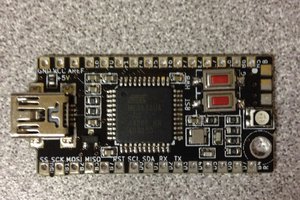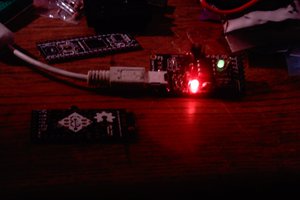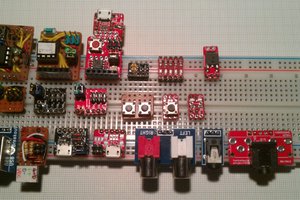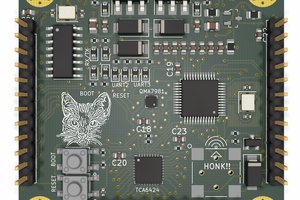To make the experience fit your profile, pick a username and tell us what interests you.
We found and based on your interests.
The PCBs arrived from @oshpark (thank you again for all the help!) and the Jolly Wrencher USB key is assembled:
As the previous board, it just runs CircuitPython, with some tiny USB mass storage for the scripts, and a serial console with the Python REPL. I imagine it could be useful for testing various sensors and displays and such — the pins I have broken out support I2C and SPI, they also all have ADC and one even has a DAC. One pin is also internally connected to the copper pour, to detect touches. But there are 20 unused GPIO pins there, and I wonder if I should add some blinky LEDs or something in there... but then the board would look much busier. I'm torn between simplicity and optimization.
I didn't particularly like how the Jolly Wrencher from the previous log came out, so I played with it a little bit more and shrunk it somewhat.
I removed the two pads from the eyes, because they made it look scared. I also rearranged them so that you have at least one i2c/spi peripheral on the pads.
And of course the OSHPark link: https://oshpark.com/shared_projects/pNBTHZMx
A version that looks closer to the Jolly Wrencher (but not identical). Instead of pads on the back it has holes for alligator clips/banana plugs/sewing.
OSHPark board here: https://oshpark.com/shared_projects/TnMcb1Nm
Every time I looked at a development board that had USB A plug integrated into its PCB, I saw the teeth of a skull. So one night when I couldn't sleep, I fired up Inkscape, drew a rectangle and three ellipses, and made this.
Once I had it imported into Fritzing, I had to decide what components to put on it. I could simply make it an USB light, with two LEDs in the eyes. Or I could make it play a melody, like the #Nyan Board. In the end, I decided to just put a SAMD21 chip on it, and make it equivalent to an Adafruit Gema M0.
You can get the boards at @oshpark if you want to make your own. It only has four components, but one of them is a QFN package, so a hot air gun is recommended.
Once the PCBs arrive, I will make a board definition for CircuitPython for it.
Create an account to leave a comment. Already have an account? Log In.
It's Atmel's part, so Chinese distributors might not carry it.
it is listed but marked as "out of stock". For example, the
ATSAMD21G18A-AU is available. I just need to watch and wait
I am new to that kind of components. I find some online resellers but there's always huge shipping costs. Is there known resellers for hobbyist?
that's what I usually do but I could not find ATSAMD21E18A.
i'll search again
Ah, yes, the samd21 I got from Mouser, I got free shipping because I was ordering some other things as well, and got it above the threshold.
a ATSAMD21E18A with AP2112K add 2 capacitors and it works ?
I really need to learn PCB to propose those kind of little board as gift in my workshop
Yeah, that atmel chip really has minimal requirements for extra components. With a 3V battery you wouldn't even need the voltage regulator!
I learn a lot with your projects. I solder again some little kits and started to learn a bit of Eagle to design.
The voltage regulator is here to allows plug in USB port ?
Do you have an advice for the 1uF capacitors?
For example, do you think those C0805 are ok?
https://www.mouser.fr/ProductDetail/KEMET/C0805C105K4RAC7210?qs=sGAEpiMZZMts0YcPTleK%252bVYr30BtzZf9
Thanks, I'm glad to hear that. Yes, the voltage regulator is there to power it from USB's 5V. If there was a battery, you could use anything from 2.8V to 4V (IIRC) directly. The capacitors are all pretty much the same, those you linked will work fine.
Nie lubie czaszek, i tak mamy za duzo samobojcow
ale jakas twarz ma sens, szczegolnie jesli by oba oczodoly byly przyciskami dotykowymi (rezystancyjne czy inne) jesli przycicki sa mechaniczne to wyrywa sie wejscie usb w komputerze.
Czy mozna dodac memrystory?
P.S. jak zwykle za malo pamieci
This project is cooll !!! (pun intended).
I would advice to remove the ground plan under the opposite side of the USB contacts to prevent that the wear out of the finishing expose the copper and short circuit the signals when the device is inserted upside down.
Thanks. I will need to glue a piece of PCB in there anyways, because it's too thin on its own.
Become a member to follow this project and never miss any updates

 The Big One
The Big One
 Ethan Durrant
Ethan Durrant
 Stefan Lochbrunner
Stefan Lochbrunner
 WingTechCorner
WingTechCorner
I still have 3 Jolly Wrencher pcbs in my drawer. The ATSAMD21E18A-MU is too hard to find.
I was hoping to find some on lcsc.com but it is out of stock for now. One day I'll solder my first surface mount component :)